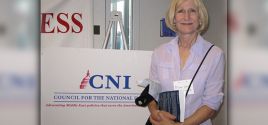Cancer-virus strains rarer than first estimated: Just 2 percent of females 14-59 are infectedBy Marie McCulloughPhiladelphia Inquirer Mar. 02, 2007 |
Popular 
FL State Sen. Randy Fine Celebrated Israel Killing an American - Trump Just Endorsed Him For Congress

Trump Nominates Pam Bondi for Attorney General

Netanyahu Cries 'Antisemitism' After International Criminal Court Issues Warrant for His Arrest

Matt Gaetz Withdraws from Consideration as Attorney General

FBI Pays Visit to Pro-Palestine Journalist Alison Weir's Home
 Related: Vaccines: The Hidden TruthThe first broad national snapshot of human papillomavirus infection shows that two dangerous strains covered by the new cervical-cancer vaccine infect just 2 percent of females ages 14 to 59, a lower prevalence than previously estimated. Even among women most likely to be infected - sexually active 18- to 25-year-olds - these two cancer-causing HPV strains were relatively uncommon, infecting 3.5 percent. Experts say these findings, published today, do not change the conclusion that the public-health benefits of vaccination are worth the cost. But the new data may create confusion and fuel controversy over whether to mandate inoculation of pubescent girls. At least 20 states are considering proposals. The study supports the notion that there should not be a "rush to make this vaccine mandatory," said Kenneth Chaiken, a Dallas lawyer representing six parents who are suing the Texas governor over his order requiring vaccination of sixth-grade girls. Barbara Loe Fisher, president of the National Vaccine Information Center, a nonprofit advocacy group that contends all vaccines pose risks the public is not warned about, said she was "shocked" by the new data. "This is not what most people in America who have looked at publicity for this vaccine were led to believe," she said. Merck & Co.'s Gardasil, which costs $360 for three shots, was approved in June for females ages 9 to 26. Since then, human papillomavirus has shot from obscurity to notoriety - without time for much public education about this huge, ubiquitous family of viruses that come and go, usually harmlessly, in sexually active people. Gardasil protects against two "high-risk" HPV strains that cause precancerous and cancerous cervical changes, plus two strains that cause genital warts. (Soon, GlaxoSmithKline expects approval of Cervarix, its rival vaccine for just those two high-risk strains.) While the new study shows a low prevalence of the two high-risk strains, their virulence is clear: They are found in 70 percent of cervical cancers. In the United States, screening programs have reduced annual cervical-cancer deaths to 3,900. The disease remains a scourge worldwide, killing 250,000. The new study, conducted by researchers at the Centers for Disease Control and Prevention, appears in today's Journal of the American Medical Association. It is the first to measure prevalence at a single point in time among a representative sample of the nation's 25 million females ages 14 to 59. Each of the 1,921 participants submitted a self-collected swab of vaginal cells. The cells were analyzed for DNA of more than two dozen strains of HPV. There are at least 100 known types. In the past, most studies of HPV infection were limited to particular groups of women - at clinics, on college campuses, or in vaccine trials. These studies found double-digit rates for the two riskiest strains. A few other HPV studies have looked at nationally representative groups, but within limited age ranges. For example, a 2002 study of adolescent health found 7.8 percent of sexually active 18-to-25-year-olds had the two riskiest HPV strains. The new data can serve as a baseline to see whether introduction of the vaccine reduces cervical cancer in coming years, said Eileen Dunne, the lead CDC researcher. "For us, this provides an opportunity to look at trends over time," she said. Among the findings: When both low- and high-risk strains are lumped together, HPV infection is even more common than previous research suggested. A quarter of females in the study were infected, including nearly half the participants ages 20 to 24. The two genital-wart-causing strains were uncommon, with a combined prevalence of 1.4 percent. Most infected females carried only one HPV type, but 16 percent had three or more types. Five HPV types known to cause cancer were more prevalent than the two in the vaccine. This last finding suggests that the types the vaccine wards off are somehow more potent or persistent, said Richard Haupt, Merck's executive director of medical affairs. Merck has been on the defensive over Gardasil recently. Last week, Merck said it was stopping its campaign to lobby states for mandatory vaccination of 11- and 12-year-old girls due to complaints from some parents, advocacy groups and health officials. Meanwhile, Fisher's advocacy group has been calling attention to reports of "adverse effects" following vaccine administration. The CDC says these are mostly minor and not necessarily caused by the vaccine. Lawrence Stanberry, a University of Texas pediatrician who wrote an editorial accompanying today's report in the medical journal, believes the real problem is that the public has not had time to learn about the world's first cancer vaccine. "Some have argued that we need greater safety data. That's fine," he said in an interview. "But I think what got short-circuited was the ability to educate the public about the benefits of the vaccine." |



